Urban Forest Above-Ground Biomass Estimation Based on UAV 3D Real Scene
Abstract
1. Introduction
2. Materials and Methods
2.1. Study Area
2.2. Data Acquisition
2.2.1. UAV Data
2.2.2. Field Measurements
2.3. Study Methods
2.3.1. UAV Visible-Light 3D Real-Scene Model Construction Method
2.3.2. Single-Wood Parameter Extraction Method
2.3.3. Single-Wood AGB Estimation Method
2.3.4. Evaluation of the Accuracy of AGB Estimation
3. Results
3.1. 3D Real-Scene Model Construction Results
3.2. Single-Wood Parameter Extraction Results
3.3. Single-Wood AGB Model Construction
3.4. Single-Wood AGB Estimation and Evaluation
4. Discussion
5. Conclusions
Author Contributions
Funding
Data Availability Statement
Acknowledgments
Conflicts of Interest
References
- Cai, Z.; Peng, B.; Ji, X.; Ji, P. Construction and application of city-level real 3D city: A case study of Linyi real 3D city. Bullet. Survey. Mapp. 2021, 11, 115–119+144. [Google Scholar]
- Zlatanova, S.; Rahman, A.A.; Shi, W. Topological models and frameworks for 3D spatial objects. Comput. Geosci. 2004, 30, 419–428. [Google Scholar] [CrossRef]
- Chen, J.; Dowman, I.; Li, S.; Li, Z.; Madden, M.; Mills, J.; Paparoditis, N.; Franz, R.; Sester, M.; Toth, C.; et al. Information from imagery: ISPRS scientific vision and research agenda. ISPRS J. Photogramm. Remote Sens. 2016, 115, 3–21. [Google Scholar] [CrossRef]
- Arruda, W.D.S.; Oldeland, J.; Filho, A.C.P.; Pott, A.; Cunha, N.L.; Ishii, I.H.; Damasceno-Junior, G.A. Inundation and Fire Shape the Structure of Riparian Forests in the Pantanal, Brazil. PLoS ONE 2016, 11, e0156825. [Google Scholar] [CrossRef]
- Zachmann, L.J.; Shaw, D.W.; Dickson, B.G. Prescribed fire and natural recovery produce similar long-term patterns of change in forest structure in the Lake Tahoe basin, California. For. Ecol. Manag. 2018, 409, 276–287. [Google Scholar] [CrossRef]
- Wang, Y.; Lehtomäki, M.; Liang, X.; Pyörälä, J.; Kukko, A.; Jaakkola, A.; Liu, J.; Feng, Z.; Chen, R.; Hyyppä, J. Is field-measured tree height as reliable as believed—A comparison study of tree height estimates from field measurement, airborne laser scanning and terrestrial laser scanning in a boreal forest. ISPRS J. Photogramm. Remote. Sens. 2019, 147, 132–145. [Google Scholar] [CrossRef]
- Wiggins, H.L.; Nelson, C.R.; Larson, A.J.; Safford, H.D. Using LiDAR to develop high-resolution reference models of forest structure and spatial pattern. For. Ecol. Manag. 2019, 434, 318–330. [Google Scholar] [CrossRef]
- Hartling, S.; Sagan, V.; Maimaitijiang, M.; Dannevik, W.; Pasken, R. Estimating tree-related power outages for regional utility network using airborne LiDAR data and spatial statistics. Int. J. Appl. Earth Obs. Geoinf. 2021, 100, 102330. [Google Scholar] [CrossRef]
- Guo, Q.; Hu, T.; Liu, J.; Jin, S.; Xiao, Q.; Yang, G.; Gao, X.; Xu, Q.; Xie, P.; Peng, Z.; et al. Advances in light weight unmanned aerial vehicle remote sensing and major industrial applications. Progress Geogr. 2021, 40, 1550–1569. [Google Scholar] [CrossRef]
- Kohek, S.; Žalik, B.; Strnad, D.; Kolmanič, S.; Lukač, N. Simulation-driven 3D forest growth forecasting based on airborne topographic LiDAR data and shading. Int. J. Appl. Earth Obs. Geoinf. 2022, 111, 102844. [Google Scholar] [CrossRef]
- Tang, L.; Peng, X.; Chen, C.; Huang, H.; Lin, D. Three-dimensional Forest growth simulation in virtual geographic environments. Int. J. Environ. Sci. Technol. 2019, 12, 31–41. [Google Scholar] [CrossRef]
- Liu, W.; Zang, Y.; Xiong, Z.; Bian, X.; Wen, C.; Lu, X.; Wang, C.; Marcato, J.; Gonçalves, W.N.; Li, J. 3D building model generation from MLS point cloud and 3D mesh using multi-source data fusion. Int. J. Appl. Earth Obs. Geoinf. 2023, 116, 103171. [Google Scholar] [CrossRef]
- Jia, X.; Zhang, Y.; Du, A. Three-dimensional characterization and calculation of highway space visual perception. Heliyon 2022, 8, e10118. [Google Scholar] [CrossRef]
- Wang, C.; Jia, X.; Zhao, Y.; Jin, H.; Liu, L.; Yin, H.; Wang, Z. Review of Methods on Estimating Forest Biomass. J. Beihua Univ. 2019, 20, 391–394. [Google Scholar]
- Jayathunga, S.; Owari, T.; Tsuyuki, S. Evaluating the Performance of Photogrammetric Products Using Fixed-Wing UAV Imagery over a Mixed Conifer–Broadleaf Forest: Comparison with Airborne Laser Scanning. Remote. Sens. 2018, 10, 187. [Google Scholar] [CrossRef]
- Li, X.; Du, H.; Zhou, G.; Mao, F.; Zhang, M.; Han, N.; Fan, W.; Liu, H.; Huang, Z.; He, S.; et al. Phenology estimation of subtropical bamboo forests based on assimilated MODIS LAI time series data. ISPRS J. Photogramm. Remote. Sens. 2021, 173, 262–277. [Google Scholar] [CrossRef]
- Yadav, S.; Padalia, H.; Sinha, S.K.; Srinet, R.; Chauhan, P. Above-ground biomass estimation of Indian tropical forests using X band Pol-InSAR and Random Forest. Remote. Sens. Appl. Soc. Environ. 2021, 21, 100462. [Google Scholar] [CrossRef]
- Li, H.; Zhang, G.; Zhong, Q.; Xing, L.; Du, H. Prediction of Urban Forest Aboveground Carbon Using Machine Learning Based on Landsat 8 and Sentinel-2: A Case Study of Shanghai, China. Remote. Sens. 2023, 15, 284. [Google Scholar] [CrossRef]
- Zhou, L.; Li, X.; Zhang, B.; Xuan, J.; Gong, Y.; Tan, C.; Huang, H.; Du, H. Estimating 3D Green Volume and Aboveground Biomass of Urban Forest Trees by UAV-Lidar. Remote. Sens. 2022, 14, 5211. [Google Scholar] [CrossRef]
- Zuo, S.D.; Ren, Y. Study on the temporal and spatial variation of forest landscape and ecological quality during the fast urbanization process. Environ. Sci. Technol. 2015, 38, 191–198. [Google Scholar] [CrossRef]
- Lin, J.; Shu, L.; Zuo, H.; Zhang, B. Experimental observation and assessment of ice conditions with a fixed-wing unmanned aerial vehicle over Yellow River, China. J. Appl. Remote. Sens. 2012, 6, 063586. [Google Scholar] [CrossRef]
- Sofonia, J.J.; Phinn, S.; Roelfsema, C.; Kendoul, F.; Rist, Y. Modelling the effects of fundamental UAV flight parameters on LiDAR point clouds to facilitate objectives-based planning. ISPRS J. Photogramm. Remote. Sens. 2019, 149, 105–118. [Google Scholar] [CrossRef]
- An, P.T.; Huyen, P.T.T.; Le, N.T. A modified Graham’s convex hull algorithm for finding the connected orthogonal convex hull of a finite planar point set. Appl. Math. Comput. 2021, 397, 125889. [Google Scholar] [CrossRef]
- Li, Q.; Li, B.; Cen, J. Research on Laser Range Scanning and lts Application. Geomat. Inform. Sci. Wuhan Univ. 2000, 4, 387–392. [Google Scholar]
- Hilker, T.; van Leeuwen, M.; Coops, N.C.; Wulder, M.A.; Newnham, G.J.; Jupp, D.L.B.; Culvenor, D.S. Comparing canopy metrics derived from terrestrial and airborne laser scanning in a Douglas-fir dominated forest stand. Trees Struct. Funct. 2010, 24, 819–832. [Google Scholar] [CrossRef]
- Guo, L.; Chehata, N.; Mallet, C.; Boukir, S. Relevance of airborne lidar and multispectral image data for urban scene classification using Random Forests. ISPRS J. Photogramm. Remote. Sens. 2011, 66, 56–66. [Google Scholar] [CrossRef]
- Wulder, M.A.; White, J.C.; Nelson, R.F.; Næsset, E.; Ørka, H.O.; Coops, N.C.; Hilker, T.; Bater, C.W.; Gobakken, T. Lidar Sampling for Large-Area Forest Characterization: A Review. Remote Sens. Environ. 2012, 121, 196–209. [Google Scholar] [CrossRef]
- Liu, H.; Zhang, Z.; Cao, L. Estimating forest stand characteristics in a coastal plain forest plantation basedon vertical structure profile parameters derived from ALS data. J. Remote Sens. 2018, 22, 872–888. [Google Scholar] [CrossRef]
- Zhang, B.; Li, X.; Du, H.; Zhou, G.; Mao, F.; Huang, Z.; Zhou, L.; Xuan, J.; Gong, Y.; Chen, C. Estimation of Urban Forest Characteristic Parameters Using UAV-Lidar Coupled with Canopy Volume. Remote. Sens. 2022, 14, 6375. [Google Scholar] [CrossRef]
- Tian, Y.; Zhang, Q.; Huang, H.; Huang, Y.; Tao, J.; Zhou, G.; Zhang, Y.; Yang, Y.; Lin, J. Aboveground biomass of typical invasive mangroves and its distribution patterns using UAV-LiDAR data in a subtropical estuary: Maoling River estuary, Guangxi, China. Ecol. Indic. 2022, 136, 108694. [Google Scholar] [CrossRef]
- Wu, P.; Ren, G.; Zhang, C.; Wang, H.; Liu, S.; Ma, Y. Fine identification and biomass estimation of mangroves based on UAV multispectral and LiDAR. Nat. Remote Sens. Bulletin. 2022, 26, 1169–1181. [Google Scholar] [CrossRef]
- Fekry, R.; Yao, W.; Cao, L.; Shen, X. Ground-based/UAV-LiDAR data fusion for quantitative structure modeling and tree parameter retrieval in subtropical planted forest. For. Ecosyst. 2022, 9, 100065. [Google Scholar] [CrossRef]
- Lin, J.; Chen, D.; Wu, W.; Liao, X. Estimating aboveground biomass of urban forest trees with dual-source UAV acquired point clouds. Urban For. Urban Green. 2022, 69, 127521. [Google Scholar] [CrossRef]
- Xu, X.; Zhou, Z.; Tang, Y.; Qu, Y. Individual tree crown detection from high spatial resolution imagery using a revised local maximum filtering. Remote. Sens. Environ. 2021, 258, 112397. [Google Scholar] [CrossRef]
- Liu, K.; Cao, L.; Wang, G.; Cao, F. Biomass allocation patterns and allometric models of Ginkgo biloba. J. Beijing For. Univ. 2017, 39, 12–20. [Google Scholar] [CrossRef]
- Cao, Z. Biomass and Distribution Pattern of Cinnamomum camphora in Yangzhou. For. Sci. Technol. 2020, 574, 69–71. [Google Scholar]
- Iglhaut, J.; Cabo, C.; Puliti, S.; Piermattei, L.; O’Connor, J.; Rosette, J. Structure from Motion Photogrammetry in Forestry: A Review. Curr. For. Rep. 2019, 5, 155–168. [Google Scholar] [CrossRef]
- Hu, Q.; Woldt, W.; Neale, C.; Zhou, Y.; Drahota, J.; Varner, D.; Bishop, A.; LaGrange, T.; Zhang, L.; Tang, Z. Utilizing unsupervised learning, multi-view imaging, and CNN-based attention facilitates cost-effective wetland mapping. Remote. Sens. Environ. 2021, 267, 112757. [Google Scholar] [CrossRef]
- Xie, L.; Lee, F.; Liu, L.; Yin, Z.; Yan, Y.; Wang, W.; Zhao, J.; Chen, Q. Improved spatial pyramid matching for scene recognition. Pattern Recognit. 2018, 82, 118–129. [Google Scholar] [CrossRef]
- Wang, Y.; Liu, X.; Yang, J.; Dang, J. Dense Matching of Multi-View Remote Sensing Terrain lmage Based on lmproved PMVS Algorithm. Laser Optoelectron. Progress 2021, 58, 516–525. [Google Scholar] [CrossRef]
- Kang, C.; Cheng, Y.; Shi, L. Application of UAV tilt photography modeling technology in virtual reality. J. Guilin Univ. Technol. 2020, 40, 138–142. [Google Scholar]
- Hao, Y.; Zhen, Z.; Li, F.; Zhao, Y. A graph-based progressive morphological filtering (GPMF) method for generating canopy height models using ALS data. Int. J. Appl. Earth Obs. Geoinf. 2019, 79, 84–96. [Google Scholar] [CrossRef]
- Fan, Z.; Li, J.; Deng, M. An Adaptive lnverse-Distance Weighting Spatial lnterpolation Method with the Consideration of Multiple Factors. Geomat. Inform. Sci. Wuhan Univ. 2016, 41, 842–847. [Google Scholar] [CrossRef]
- Chen, Z.; Liu, Q.; Li, C.; Li, M.; Zhou, X.; Yu, Z.; Su, K. Comparison in linear and nonlinear estimation models of carbon storage of plantations based on UAV LiDAR. J. Beijing For. Univ. 2021, 43, 9–16. [Google Scholar]
- Feng, Y.; Lu, D.; Chen, Q.; Keller, M.; Moran, E.; Dos-Santos, M.N.; Bolfe, E.L.; Batistella, M. Examining effective use of data sources and modeling algorithms for improving biomass estimation in a moist tropical forest of the Brazilian Amazon. Int. J. Digit. Earth 2017, 10, 996–1016. [Google Scholar] [CrossRef]
- Pati, P.K.; Kaushik, P.; Khan, M.; Khare, P. Allometric equations for biomass and carbon stock estimation of small diameter woody species from tropical dry deciduous forests: Support to REDD+. Trees, For. People 2022, 9, 100289. [Google Scholar] [CrossRef]
- Münzinger, M.; Prechtel, N.; Behnisch, M. Mapping the urban forest in detail: From LiDAR point clouds to 3D tree models. Urban For. Urban Green. 2022, 74, 127637. [Google Scholar] [CrossRef]
- Qin, H.; Zhou, W.; Yao, Y.; Wang, W. Individual tree segmentation and tree species classification in subtropical broadleaf forests using UAV-based LiDAR, hyperspectral, and ultrahigh-resolution RGB data. Remote. Sens. Environ. 2022, 280, 113143. [Google Scholar] [CrossRef]
- Anderson, K.; Gaston, K.J. Lightweight unmanned aerial vehicles will revolutionize spatial ecology. Front. Ecol. Environ. 2013, 11, 138–146. [Google Scholar] [CrossRef]
- Zellweger, F.; Braunisch, V.; Baltensweiler, A.; Bollmann, K. Remotely sensed forest structural complexity predicts multi species occurrence at the landscape scale. For. Ecol. Manag. 2013, 307, 303–312. [Google Scholar] [CrossRef]
- Geng, L.; Li, M.; Fan, W.; Wang, B. Individual Tree Structure Parameters and Effective Crown of the Stand Extraction Base on Airborn LiDAR Data. Sci. Silvae Sinicae. 2018, 54, 62–72. [Google Scholar] [CrossRef]
- Wang, D.; Wan, B.; Liu, J.; Su, Y.; Guo, Q.; Qiu, P.; Wu, X. Estimating aboveground biomass of the mangrove forests on northeast Hainan Island in China using an upscaling method from field plots, UAV-LiDAR data and Sentinel-2 imagery. Int. J. Appl. Earth Obs. Geoinf. 2020, 85, 101986. [Google Scholar] [CrossRef]
- Xu, Z.; Shen, X.; Cao, L.; Coops, N.C.; Goodbody, T.R.; Zhong, T.; Zhao, W.; Sun, Q.; Ba, S.; Zhang, Z.; et al. Tree species classification using UAS-based digital aerial photogrammetry point clouds and multispectral imageries in subtropical natural forests. Int. J. Appl. Earth Obs. Geoinf. 2020, 92, 102173. [Google Scholar] [CrossRef]
- Donager, J.; Sankey, T.T.; Meador, A.J.S.; Sankey, J.B.; Springer, A. Integrating airborne and mobile lidar data with UAV photogrammetry for rapid assessment of changing forest snow depth and cover. Sci. Remote. Sens. 2021, 4, 100029. [Google Scholar] [CrossRef]
- Scheeres, J.; de Jong, J.; Brede, B.; Brancalion, P.H.; Broadbent, E.N.; Zambrano, A.M.A.; Gorgens, E.B.; Silva, C.A.; Valbuena, R.; Molin, P.; et al. Distinguishing forest types in restored tropical landscapes with UAV-borne LIDAR. Remote. Sens. Environ. 2023, 290, 113533. [Google Scholar] [CrossRef]
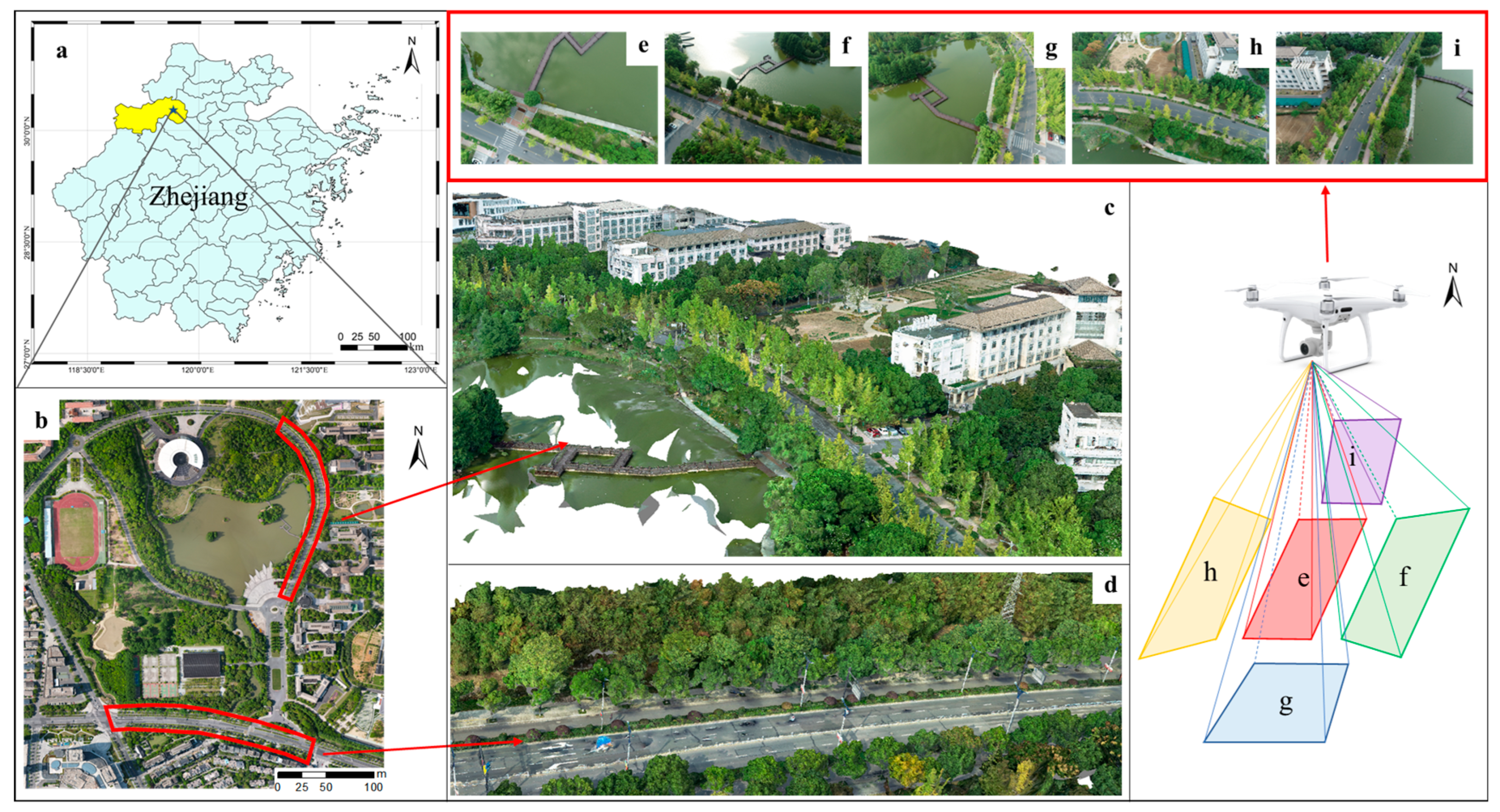
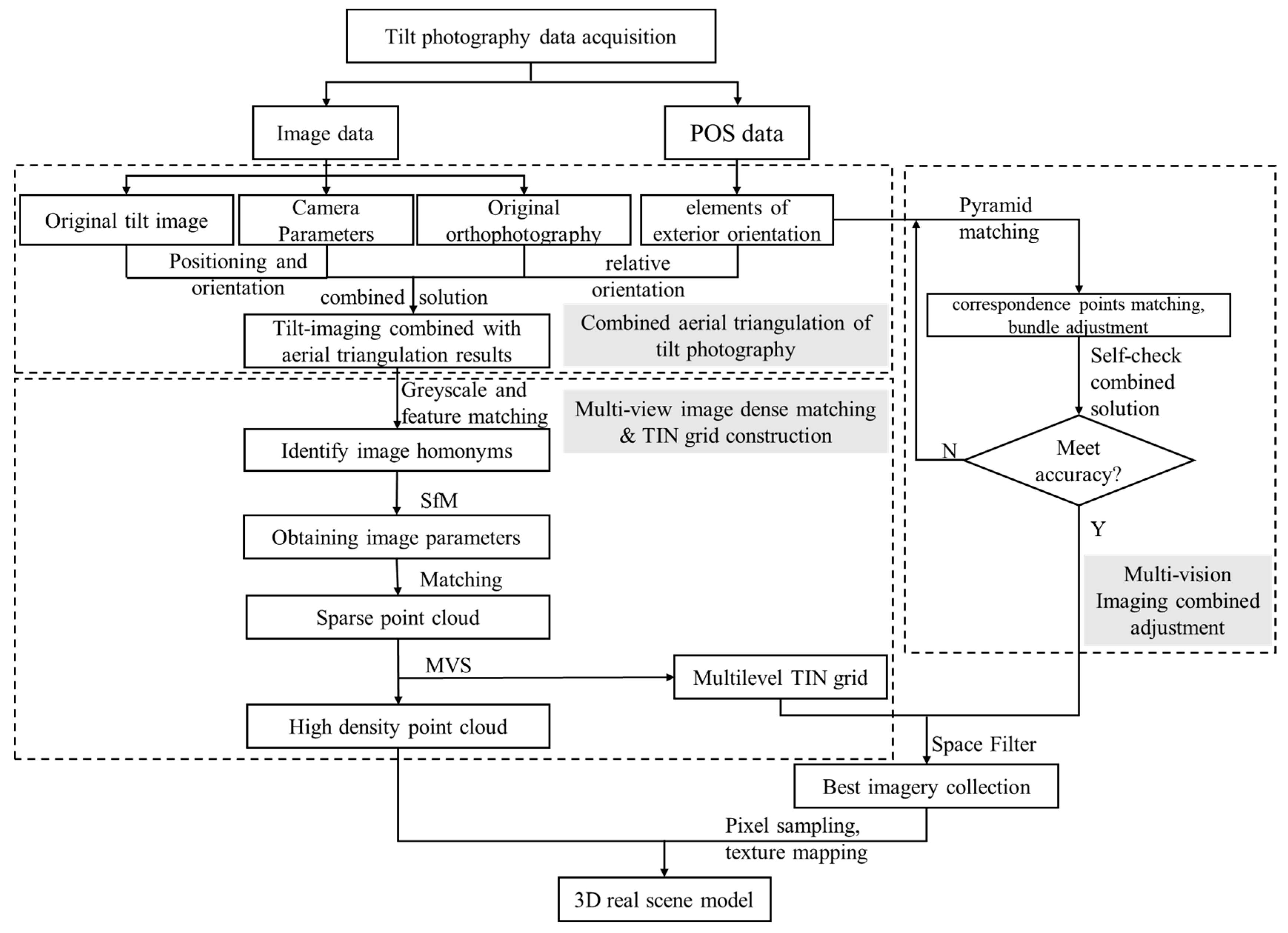

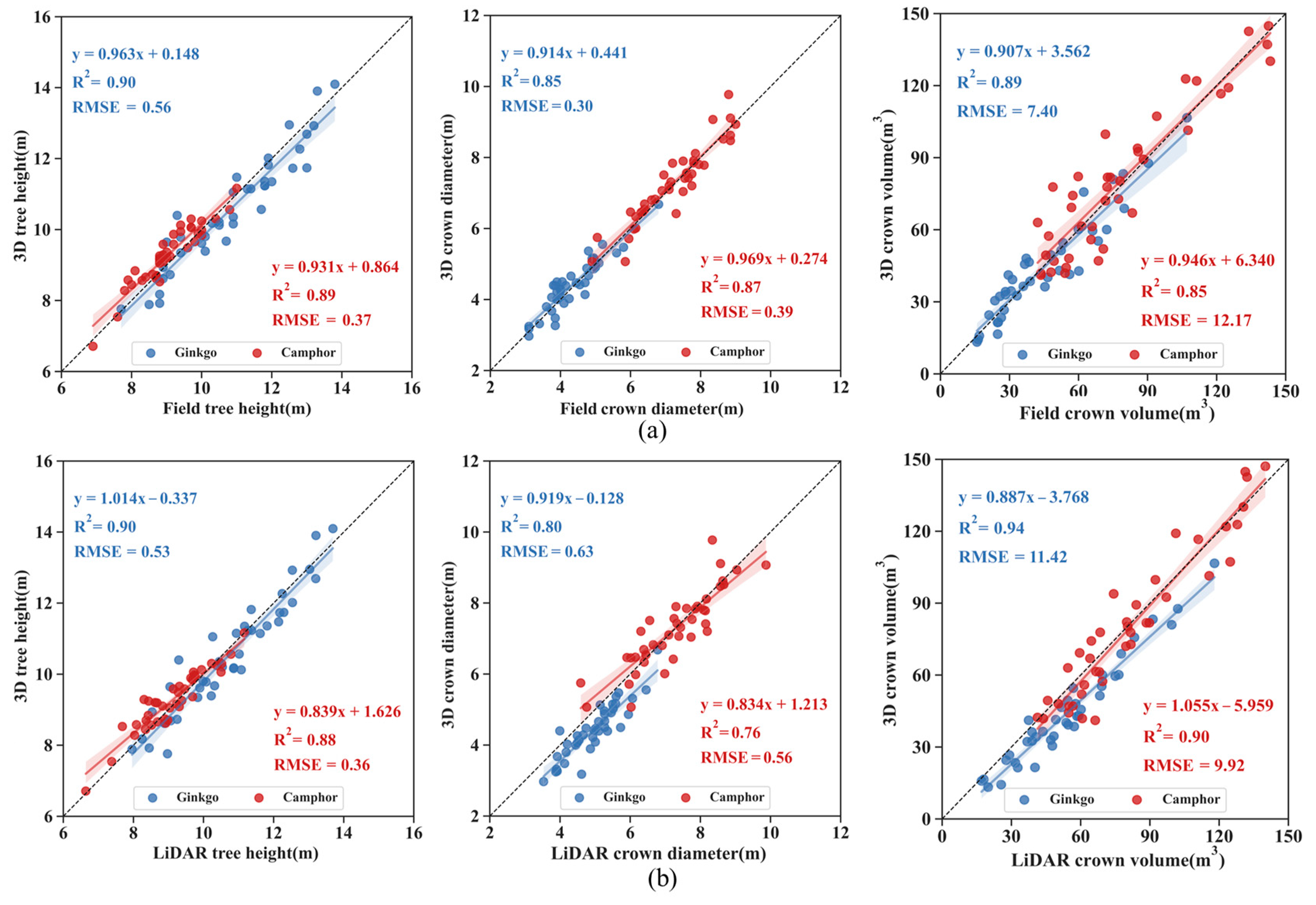

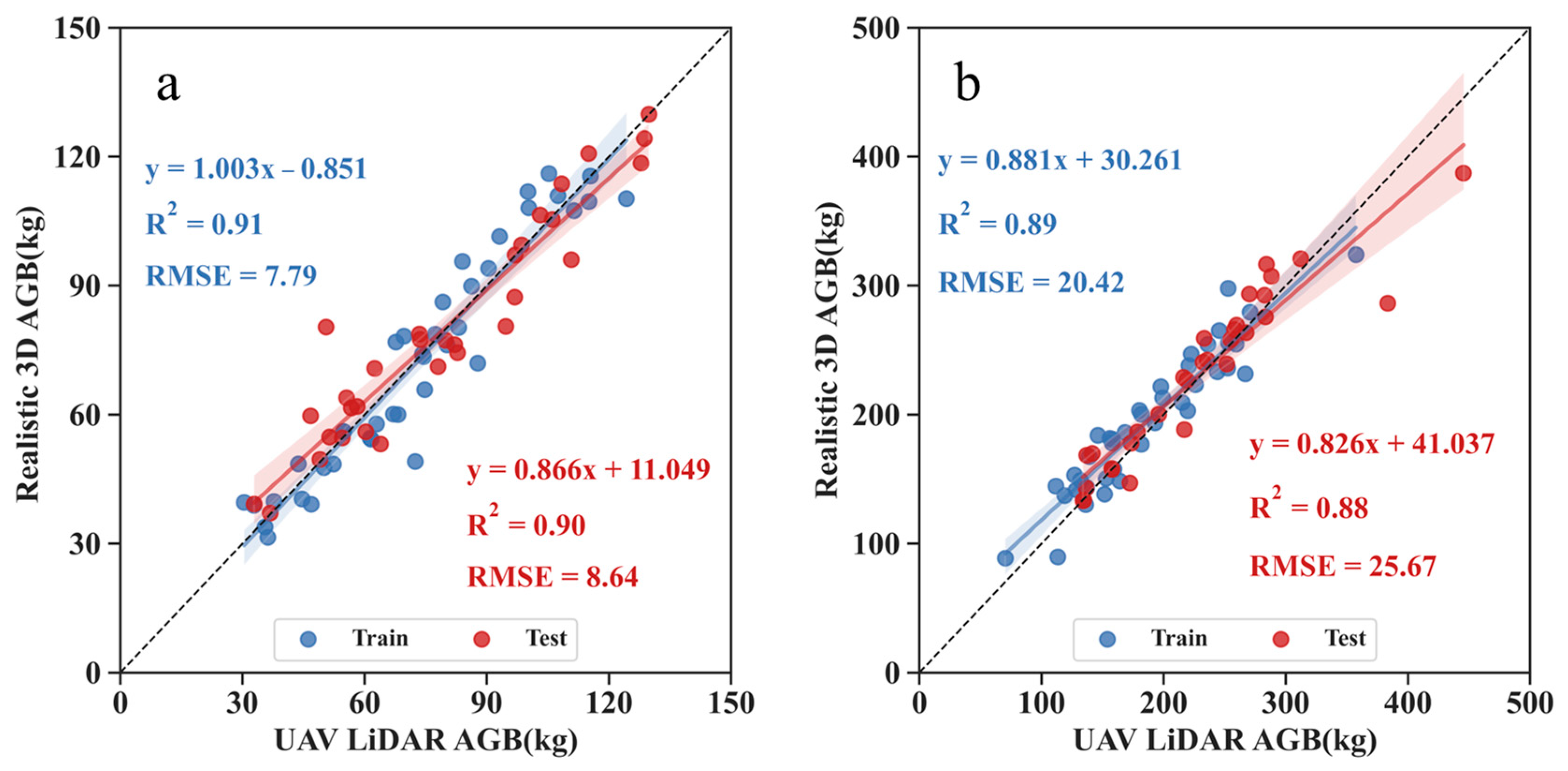
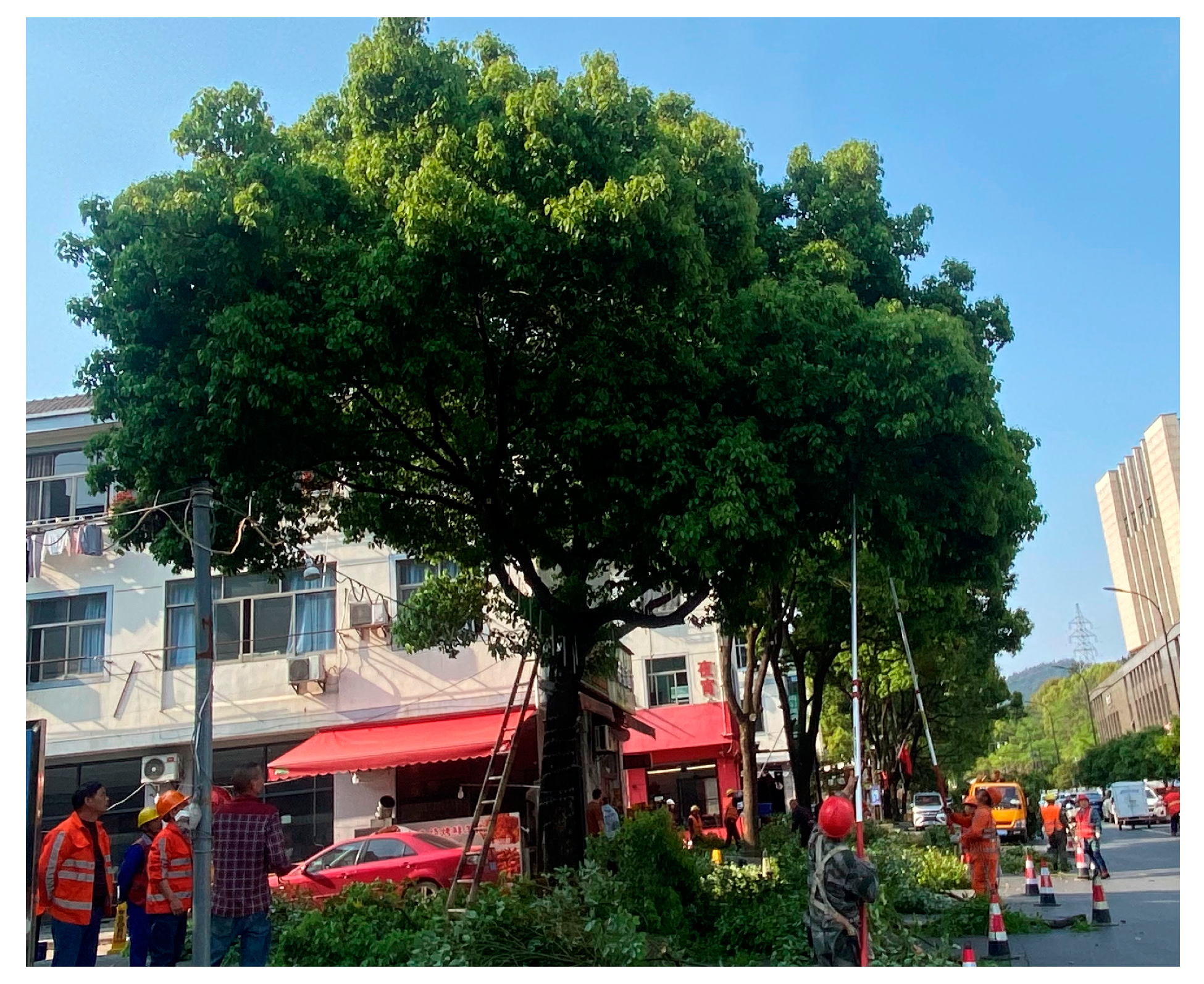

| Tree Species | Number | DBH 1 Range/m | DBH Mean/m | H 2 Range/m | H Mean/m |
|---|---|---|---|---|---|
| Ginkgo | 70 | 0.149–0.228 | 0.187 | 6.8–14.3 | 11.1 |
| Camphora | 70 | 0.157–0.308 | 0.230 | 6.2–11.0 | 8.6 |
| Tree Species | Biomass Allometric Equations | References |
|---|---|---|
| Ginkgo | [35] | |
| Camphora | [36] |
| Group 1: Tree Height, Crown Diameter | Group 2: Tree Height, Crown Volume |
|---|---|
| 1 | 2 |
| Species | Model | Train | Test | ||
|---|---|---|---|---|---|
| R2 | RMSE/ (kg) | R2 | RMSE/ (kg) | ||
| Ginkgo | AGB = 7.029 × Rc + 13.608 × H − 101.141 | 0.91 | 8.34 | 0.94 | 6.62 |
| AGB = 0.847 × 2 + 13.503 × H − 85.978 | 0.89 | 8.68 | 0.94 | 7.18 | |
| AGB = 0.103 × (Rc + H)2.415 | 0.89 | 8.97 | 0.92 | 8.01 | |
| AGB = 0.731 × (Rc × H)1.191 | 0.84 | 10.79 | 0.82 | 12.46 | |
| AGB = 171.008 × ln(Rc + H) − 387.496 | 0.86 | 10.10 | 0.88 | 9.78 | |
| AGB = 81.401 × ln(Rc × H) − 237.345 | 0.80 | 12.12 | 0.80 | 12.70 | |
| Camphora | AGB = 1.564 ×Rc + 64.574 × H − 421.276 | 0.89 | 20.75 | 0.90 | 30.46 |
| AGB = 0.189 ×2 + 63.811 × H − 413.120 | 0.88 | 21.51 | 0.90 | 30.09 | |
| AGB = 0.133 × (Rc + H)2.574 | 0.67 | 34.29 | 0.67 | 49.11 | |
| AGB = 1.343 × (Rc × H)1.168 | 0.74 | 30.79 | 0.80 | 43.71 | |
| AGB = 418.021 × ln(Rc + H) − 983.588 | 0.81 | 27.07 | 0.84 | 39.74 | |
| AGB = 191.899 × ln(Rc × H) − 617.997 | 0.77 | 29.57 | 0.77 | 43.74 | |
| Species | Model | Train | Test | ||
|---|---|---|---|---|---|
| R2 | RMSE/ (kg) | R2 | RMSE/ (kg) | ||
| Ginkgo | AGB = 0.281 × Vc + 59.488 × H − 385.314 | 0.93 | 8.22 | 0.96 | 6.02 |
| 2 + 10.608 × H − 55.112 | 0.91 | 8.58 | 0.94 | 7.15 | |
| AGB = 2.624 × (Vc + H)0.790 | 0.90 | 8.90 | 0.92 | 7.96 | |
| AGB = 2.121 × (Vc × H)0.553 | 0.88 | 9.62 | 0.90 | 8.66 | |
| AGB = 54.151 × ln(Vc+ H) − 150.733 | 0.84 | 12.06 | 0.87 | 10.56 | |
| AGB = 37.595 × ln(Vc× H) − 162.958 | 0.83 | 11.11 | 0.89 | 9.60 | |
| Camphora | AGB = 0.281 × Vc + 59.488 × H − 385.314 | 0.91 | 19.27 | 0.90 | 29.53 |
| 2 + 59.686 × H − 376.165 | 0.90 | 20.75 | 0.92 | 27.74 | |
| AGB = 14.769 × (Vc+ H)0.569 | 0.77 | 29.38 | 0.75 | 45.73 | |
| AGB = 6.629 × (Vc × H)0.508 | 0.76 | 25.83 | 0.74 | 44.37 | |
| AGB = 104.272 × ln(Vc+ H) − 274.272 | 0.80 | 31.56 | 0.86 | 36.92 | |
| AGB = 91.899 × ln(Vc × H) − 412.214 | 0.83 | 21.76 | 0.83 | 35.09 | |
| Ginkgo | Camphor | |||||||||||
|---|---|---|---|---|---|---|---|---|---|---|---|---|
| Train | Test | Train | Test | |||||||||
| Min | Max | Average | Min | Max | Average | Min | Max | Average | Min | Max | Average | |
| Field | 32.60 | 134.85 | 75.20 | 32.85 | 129.78 | 78.34 | 79.72 | 373.32 | 188.34 | 116.14 | 448.85 | 229.28 |
| 3D | 34.36 | 138.05 | 77.83 | 41.60 | 129.40 | 79.85 | 65.30 | 376.88 | 190.22 | 133.32 | 367.42 | 222.70 |
| LiDAR | 31.49 | 120.28 | 76.57 | 33.55 | 128.78 | 79.02 | 77.37 | 362.26 | 189.87 | 133.84 | 445.48 | 230.39 |
Disclaimer/Publisher’s Note: The statements, opinions and data contained in all publications are solely those of the individual author(s) and contributor(s) and not of MDPI and/or the editor(s). MDPI and/or the editor(s) disclaim responsibility for any injury to people or property resulting from any ideas, methods, instructions or products referred to in the content. |
© 2023 by the authors. Licensee MDPI, Basel, Switzerland. This article is an open access article distributed under the terms and conditions of the Creative Commons Attribution (CC BY) license (https://creativecommons.org/licenses/by/4.0/).
Share and Cite
Zhao, Y.; Zhou, L.; Chen, C.; Li, X.; Du, H.; Yu, J.; Lv, L.; Huang, L.; Song, M. Urban Forest Above-Ground Biomass Estimation Based on UAV 3D Real Scene. Drones 2023, 7, 455. https://doi.org/10.3390/drones7070455
Zhao Y, Zhou L, Chen C, Li X, Du H, Yu J, Lv L, Huang L, Song M. Urban Forest Above-Ground Biomass Estimation Based on UAV 3D Real Scene. Drones. 2023; 7(7):455. https://doi.org/10.3390/drones7070455
Chicago/Turabian StyleZhao, Yinyin, Lv Zhou, Chao Chen, Xuejian Li, Huaqiang Du, Jiacong Yu, Lujin Lv, Lei Huang, and Meixuan Song. 2023. "Urban Forest Above-Ground Biomass Estimation Based on UAV 3D Real Scene" Drones 7, no. 7: 455. https://doi.org/10.3390/drones7070455
APA StyleZhao, Y., Zhou, L., Chen, C., Li, X., Du, H., Yu, J., Lv, L., Huang, L., & Song, M. (2023). Urban Forest Above-Ground Biomass Estimation Based on UAV 3D Real Scene. Drones, 7(7), 455. https://doi.org/10.3390/drones7070455







